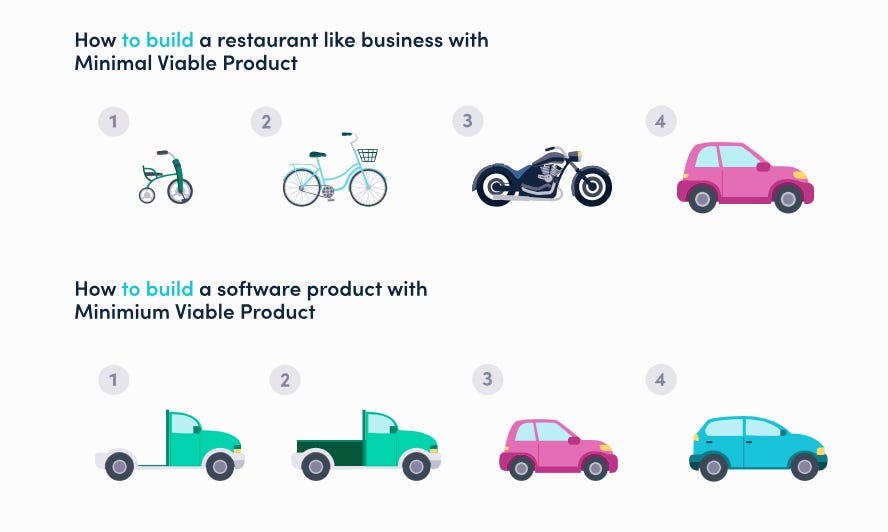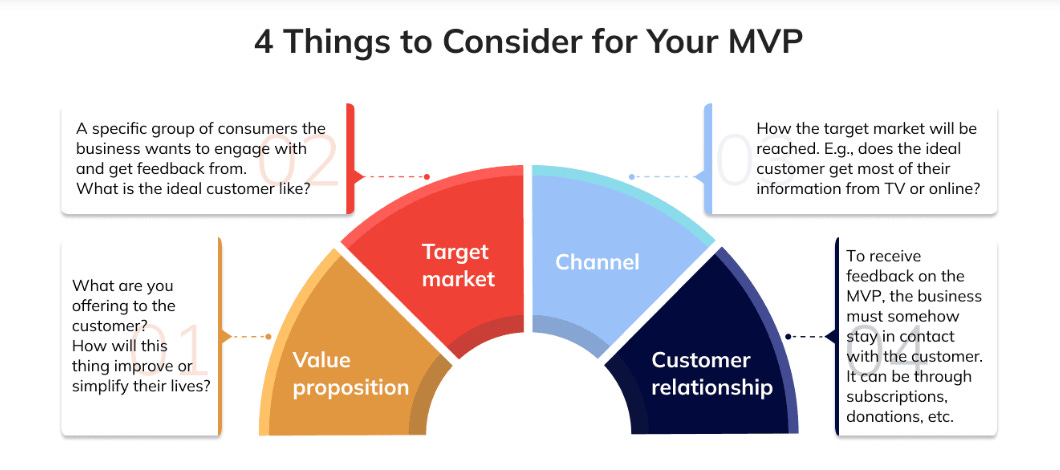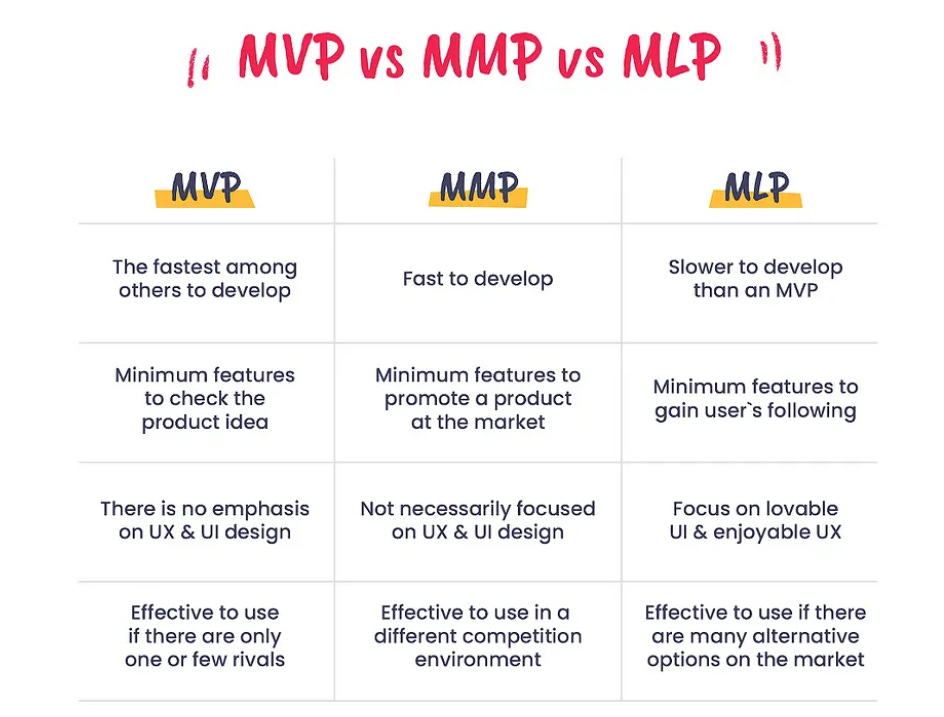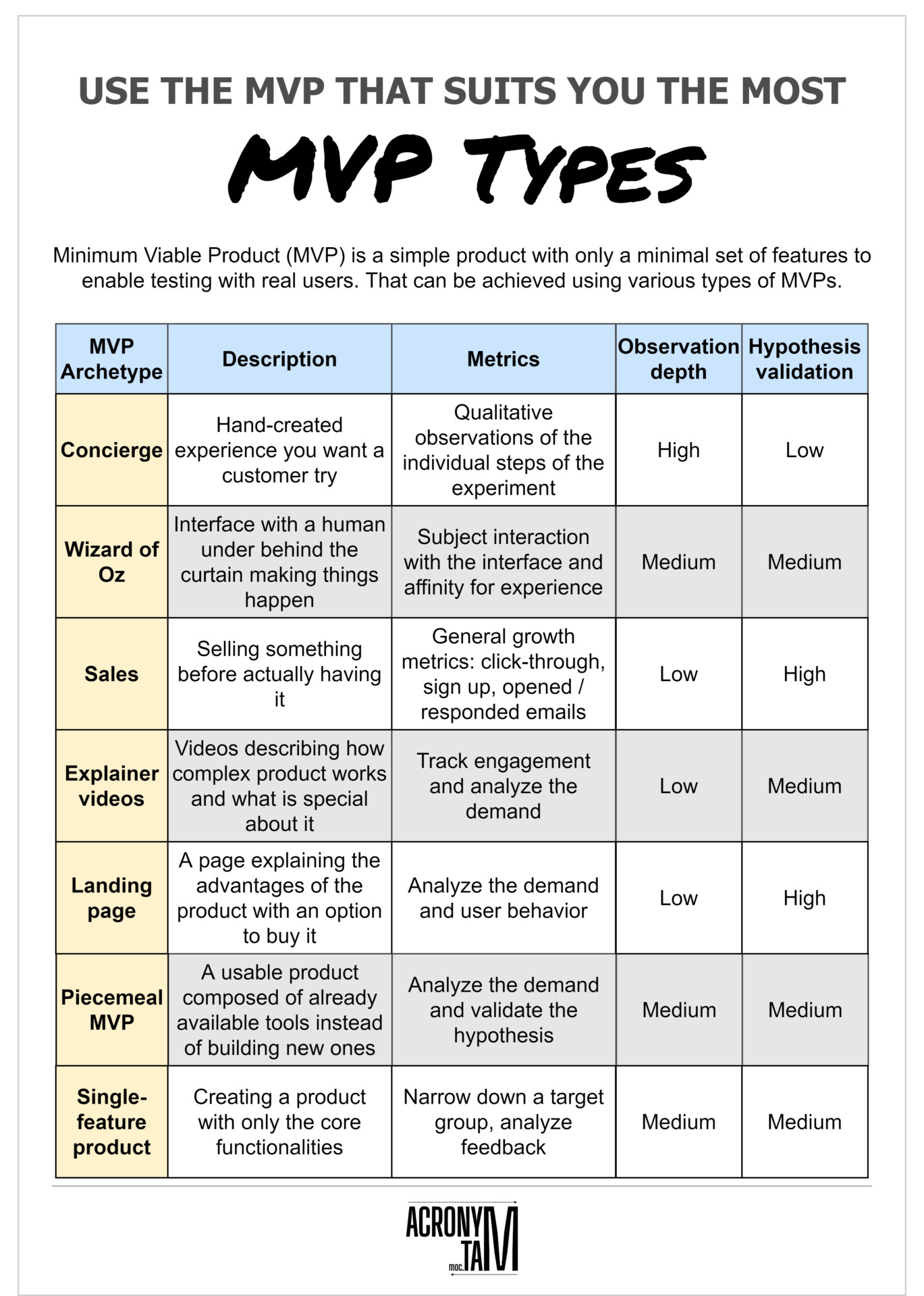A Guide to Minimum Viable Product (MVP) in Product Management
How to get early adopters of your product with bare minimum features to validate your idea.
👋🏻 Hey there, welcome to the #21st edition of the Product Space Newsletter, where we help you become better at product management.
An MVP is a product version with just enough features to gather early user feedback and validate core assumptions. It’s as a way to test the waters before diving head first into full-scale development. This approach allows teams to validate ideas, reduce risk, and iterate quickly, ultimately leading to more successful products.
In this article, we will explore what an MVP is, how to build one, and how it fits into the broader context of product development alongside related strategies, and provide practical tips for implementation.
Concept of an MVP
At its core, a Minimum Viable Product (MVP) is a product with just enough features to satisfy early adopters and provide feedback for future development. The idea is to create a functional version of the product that can be tested in the market with the least amount of effort and resources. The MVP helps to validate whether the product idea is worth pursuing further.
Core Principles of MVP
An MVP is often confused with simply throwing together a basic version of your product. However, there's a crucial distinction. An effective MVP is strategic and well-defined. Here are some key principles to keep in mind:
Focus on solving one core problem: The MVP should address the most critical pain point of your target users. By focusing on a single, core problem, you can ensure that the MVP delivers real value, even if it’s minimal.
Minimum viable, not minimal: The focus of an MVP is to include the absolute essential features that enable users to experience the core value proposition of your product. Don't be tempted to skimp on quality or user experience in the name of speed.
Focus on learning: The primary objective of an MVP is to validate your assumptions and gather learnings about your target market. The feedback you receive should guide future product development iterations.
It's not just a prototype: An MVP is a functional product that can be used by real users. While it may lack some features, it should be a complete representation of the core product idea.
It's not a final product: The MVP is a starting point, not the finished product. It's designed to evolve and improve based on user feedback.
Here's an analogy to illustrate the concept of MVP: Imagine you're opening a restaurant. Instead of investing in a grand opening and a full menu right away, you could start with a limited menu of your most popular dishes. This allows you to test your concept, gauge customer response, and refine your offerings before making a full-scale investment.
The MVP Development Process
The MVP (Minimum Viable Product) Development Process is a structured approach that allows product teams to build and launch a product with just enough features to satisfy early users and gather feedback.
Here’s a breakdown of each step:
Define the problem and target audience:
Begin by thoroughly understanding the pain points your customers face and the needs they want to fulfill. This involves conducting market research, engaging in user interviews, and analyzing competitor products to gather valuable insights. The goal is to identify the specific problem your product will solve and who the target audience is.
Identify the core functionality:
Once you’ve defined the problem, focus on determining the essential features that will solve the customer’s problem. Prioritize these features using techniques like user story mapping, which visualizes the user journey, or the MoSCoW method, which categorizes features into Must have, Should have, Could have, and Won't have. This ensures that the MVP includes only the necessary features to deliver value.
Build the MVP:
With the core functionality identified, develop a basic version of the product. The MVP should be a simple yet functional version that addresses the primary problem. This could take the form of a landing page or a simple working product. The key is to build something that can be quickly launched to gather real-world feedback.
Test and gather feedback:
After launching the MVP, collect feedback from users through methods like beta testing, usability studies, or early market validation. Use tools such as surveys, user interviews, and analytics to gather both quantitative and qualitative data. This feedback is crucial for understanding how users interact with the product and where improvements are needed.
Iterate and improve:
The final step involves using the feedback to refine the product. This could mean fixing issues, enhancing features, or adding new ones based on user needs. The development process is iterative, meaning that the product should continuously evolve with each iteration. Create a roadmap that aligns with user feedback and business goals, ensuring that the product meets the market's needs as it grows.
Related Concepts: MMP and MLP
While the MVP is a powerful tool, it is not the end of the product journey. After validating the core idea with an MVP, product managers often move on to develop a Minimum Marketable Product (MMP) and eventually a Minimum Lovable Product (MLP).
Minimum Marketable Product (MMP)
While the MVP is focused on learning and validating assumptions, the MMP is focused on marketing. The MMP is about delivering a product that can be marketed and sold.
The transition from MVP to MMP involves adding the necessary features to make the product viable in the market, such as enhanced user interface (UI), security features, or additional integrations and generate revenue.
Minimum Lovable Product (MLP)
The MLP goes a step further than the MMP by focusing on creating a deep emotional connection with users. An MLP is designed to not just meet user needs but to delight them, fostering brand loyalty and satisfaction.
In competitive markets, creating an emotional connection can be the difference between a good product and a great product. An MLP might include thoughtful design, seamless user experience, or unique features that resonate with users on a personal level.
When and How to Use MVP, MMP, and MLP
Choosing between MVP, MMP, and MLP depends on your product’s stage, business goals, and market context. Early in the product lifecycle, focus on the MVP to validate your core idea. As you prepare to scale, shift towards building an MMP to establish a market presence. Finally, as you seek to dominate the market or build a loyal customer base, evolve your product into an MLP.
From MVP to MMP: Once the MVP has validated the core idea, begin adding features that enhance the product’s usability, reliability, and appeal to a broader audience. This might include better design, more robust infrastructure, or additional functionalities.
From MMP to MLP: To create an MLP, focus on refining the user experience. This could involve improving the product’s design, adding personalization options, or creating features that users find delightful and indispensable.
Types of MVP: What They Are, How They Work, and Real-World Examples
When it comes to building a Minimum Viable Product (MVP), there isn’t a one-size-fits-all approach. Different types of MVPs can be used depending on the product, market, and goals of the business. Understanding the various types can help product managers and founders choose the most suitable method to validate their product ideas effectively.
Here’s a breakdown of the most common types of MVPs, how they work, and examples of companies that have successfully used them.
1. Concierge MVP
What it is:
A Concierge MVP is a manual version of a service that is usually automated. Instead of building a fully functional product, you offer a hands-on, personalized service to a small group of users to validate your idea.
How it works:
In a Concierge MVP, the product team does everything manually that would eventually be automated in the final product. This allows the team to test the concept without investing in complex software or infrastructure. The goal is to interact closely with users, gather detailed feedback, and iterate based on their needs.
Example:
Airbnb initially started as a type of Concierge MVP. The founders wanted to test the idea of renting out space in their apartment to people who needed a place to stay. They didn't build a full-fledged platform at the start. Instead, they manually set up a basic website with photos of their apartment and offered a simple booking service.
They handled everything manually—interacting with guests, coordinating bookings, and providing hospitality. This approach allowed them to validate the demand for short-term rentals and gather valuable feedback before investing in building the full Airbnb platform
2. Wizard of Oz MVP
What it is:
The Wizard of Oz MVP is similar to the Concierge MVP but with a twist. Users believe they are interacting with a fully functioning product, but behind the scenes, everything is done manually by the team.
How it works:
In this approach, you create a front-end that looks like a finished product, but the back-end processes are done manually. Users are unaware that the product is not fully developed. This method is useful for testing user interactions and validating the concept without building complex technology.
Example:
Zappos started as a Wizard of Oz MVP. The founder wanted to test whether people would buy shoes online, so he took pictures of shoes from local stores and posted them on a website. When a customer placed an order, he would purchase the shoes from the store and ship them. This validated the demand for online shoe shopping before investing in inventory.
3. Piecemeal MVP
What it is:
A Piecemeal MVP is built by combining existing tools and services to create a product. Instead of developing a product from scratch, you use available resources to offer a solution that meets your users' needs.
How it works:
This approach leverages existing tools, software, and platforms to create a functional product. It minimizes development time and costs while allowing you to test the market and gather user feedback. Once the idea is validated, you can develop custom solutions to replace the piecemeal components.
Example:
Groupon started as a simple WordPress website with daily deals that were manually processed by the team. They used third-party email marketing tools to send out deals and manually tracked purchases. This piecemeal approach allowed them to validate their business model before building their platform.
4. Single-Feature MVP
What it is:
A Single-Feature MVP focuses on delivering one key feature that solves the most critical problem for your users. The idea is to strip down the product to its core functionality and test whether that feature resonates with users.
How it works:
You identify the most crucial feature of your product and develop only that feature for the MVP. This approach allows you to test whether the feature is valuable enough for users before expanding the product. It’s a fast and cost-effective way to validate the product’s core value proposition.
Example:
Twitter started as a single-feature product that allowed users to post short status updates. The simplicity of the feature resonated with users, and it grew into a global social media platform. The focus on a single feature helped Twitter validate the idea quickly and efficiently.
5. Landing Page MVP
What it is:
A Landing Page MVP is a simple web page that describes your product, its features, and the benefits to users. It often includes a call-to-action, such as a sign-up form, to gauge interest.
How it works:
You create a landing page that showcases your product idea and directs visitors to take action, such as signing up for a waiting list or providing their email. The number of sign-ups or interactions indicates the level of interest in your product. This approach allows you to validate demand before building the actual product.
Example:
Dropbox used a landing page MVP to gauge interest in their file-sharing service. They created a simple landing page with a video explaining the product’s concept. The overwhelming response validated the idea, and they proceeded to build the product.
6. Prototype MVP
What it is:
A Prototype MVP is an early version of the product, often in the form of wireframes or mockups. It’s used to showcase the product concept and gather feedback from potential users or stakeholders.
How it works:
You create a visual representation of the product, such as sketches, wireframes, or interactive mockups, that demonstrates the product’s key features. This approach is useful for gathering early feedback and refining the product idea before investing in development.
Example:
InVision started as a prototype MVP. The founders created a simple prototype of their design collaboration tool to show potential users how it would work. The positive feedback from designers and stakeholders helped them secure funding and build the full product.
Practical Tips for Product Managers
Building the right MVP
Clearly communicate the purpose and scope of the MVP to stakeholders. Ensure everyone understands that the MVP is a tool for learning, not a finished product.
Define what success looks like for your MVP. Set specific, measurable goals, such as user engagement metrics, conversion rates, or customer feedback scores.
Navigating stakeholder expectations
Stakeholders may push for more features in the MVP. Remind them of the MVP’s purpose and keep the focus on the core problem.
There may be pressure to launch quickly. While speed is important, ensure that the MVP is of sufficient quality to provide meaningful insights.
Using data to iterate
Use data to guide your iterations. Track how users interact with the MVP and use this information to make informed decisions about what to build next.
Create a feedback loop where user insights are continuously collected and fed back into the product development process. This ensures that the product evolves in line with user needs.
Common Pitfalls to Avoid While Building an MVP
Don’t overcomplicate the MVP, and resist the urge to add unnecessary features. The goal of an MVP is to test a hypothesis, not to build a fully-featured product.
Ensure you understand the context of the feedback. Early users may have different needs or expectations than the broader market.
If the MVP reveals that the product idea is flawed, don’t be afraid to pivot. The MVP is a learning tool, not a commitment to a specific product direction.
Conclusion
The Minimum Viable Product (MVP) is a powerful tool enabling you to validate ideas quickly and with minimal resources. However, the MVP is just the beginning.
As your product evolves, transitioning to a Minimum Marketable Product (MMP) and eventually a Minimum Lovable Product (MLP) ensures that you not only meet market demands but also create a product that users love and balancing the practical aspects of product development with the need to delight users is crucial.
Suggested reading:
That’s a wrap for today!
Do you have a question or a story to tell about MVPs? We’d love to hear from you!
Share in the comments below or reply to this email.
Until next time, keep innovating, keep iterating, and above all, keep being awesome.
Cheers!
Product Space





